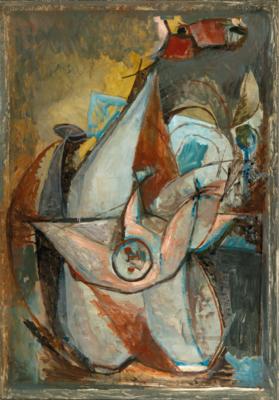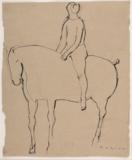Marino Marini *

(Pistoia 1901–1980 Viareggio)
Miracolo di colore, 1955, signed, dated and titled on the reverse, oil on paper laid down on canvas, 121.6 x 85 cm, framed
This work is registered in the Archivio of the Fondazione Marino Marini, Pistoia and is accompanied by a photo certificate of the Fondazione Marino Marini.
Provenance:
Carlo Bilotti, New York, by 1970
Christian Fayt Art Gallery, Knokke-Heist
acquired from the above by the present owner on 13 November 1987.
Exhibited:
Rome, Palazzo Venezia, Marino Marini, March – June 1966.
Milan, Galleria Toninelli, 15 dipinti di Marino Marini, October – November 1967.
Literature:
F. Russoli, Marino Marini, sculpture, painting, drawing, London, 1970, no. 249, ill.
H. Read, P. Waldberg & G. di San Lazzaro, Marino Marini, Complete Works, New York, 1970, no. 225, page 427, ill. page 433.
Published in:
Marino Marini. Malerei/Peinture, Bad Homburg: edition Scheffel, 1987, ill. 318.
“Abstraction and naturalism, meaning and structure of form are in perfect balance in Marini's paintings. The design medium remains bound to the laws of the two-dimensional surface. Similar to Cubist paintings, spatial movements result from the modulation of the surface aided by the distance values of colour. (...) Marini, like few others, felt that the humanist modern age to which he belonged was coming to an end. Man, martyred in chaos, remains the measure of Marini’s art even in his late work.”
Erich Steingäber, “Vorwort”, in: Marino Marini. Malerei/Peinture,
Bad Homburg: Edition Scheffel, 1987, p. XI.
Marino Marini’s work concentrates on a few age-old motifs – horse and rider, acrobats, the figure of the woman and the portrait – which he modifies again and again in powerful new ways. From an initial artistic stance oriented towards the classical ideal and inspired by Cubism and Etruscan art, he develops his characteristic archaic and abstract simplification of form. His notably memorable equestrian portraits deal with the inner as well as outer relationship between horse and rider, shaping them as a symbol of man’s tragic existence and lost mastery of nature. Faced with the painful experiences of war, his depictions become increasingly expressive and abstract embodiments of a struggle against despair and ruin. Marini is thus considered one of the most outstanding sculptors of the 20th century, alongside Alberto Giacometti and Henry Moore. His growing international recognition saw him take part in the Kassel documenta exhibition three times; in 1973, the “Museo Marino Marini” was opened in his honour in the Milan Galleria civica d’arte, followed by the Museo Marino Marini in Florence in 1988.
From the late 1940s, Marini increasingly devoted himself to painting and graphic art as an independent means of expression in parallel with his sculptural work.
In the painting Miracolo di Colore from 1955, he develops the theme of the falling horseman, the miracolo, from the rear. With legs spread wide and arms thrown up, the rider literally falls towards the viewer, under the ponderous body of the horse, which has also fallen to the ground and is stretching its head painfully into the air with its neck elongated. An impressive dynamic unfolds in the interplay of the expressive painting style and the bold yet balanced composition, giving expression to the rider's lack of support. The angular, cubic surfaces and colours are arranged in counterpoint, starting from the centre of the body. The bodies of man and animal almost dissolve in this division of forms and merge into an emotional unity: beauty and downfall, self-assertion and disempowerment, power and catastrophe meet here.
Specialist: Mag. Patricia Pálffy
 Mag. Patricia Pálffy
Mag. Patricia Pálffy
+43-1-515 60-386
patricia.palffy@dorotheum.at
31.05.2022 - 17:00
- Realized price: **
-
EUR 190,500.-
- Estimate:
-
EUR 150,000.- to EUR 200,000.-
Marino Marini *
(Pistoia 1901–1980 Viareggio)
Miracolo di colore, 1955, signed, dated and titled on the reverse, oil on paper laid down on canvas, 121.6 x 85 cm, framed
This work is registered in the Archivio of the Fondazione Marino Marini, Pistoia and is accompanied by a photo certificate of the Fondazione Marino Marini.
Provenance:
Carlo Bilotti, New York, by 1970
Christian Fayt Art Gallery, Knokke-Heist
acquired from the above by the present owner on 13 November 1987.
Exhibited:
Rome, Palazzo Venezia, Marino Marini, March – June 1966.
Milan, Galleria Toninelli, 15 dipinti di Marino Marini, October – November 1967.
Literature:
F. Russoli, Marino Marini, sculpture, painting, drawing, London, 1970, no. 249, ill.
H. Read, P. Waldberg & G. di San Lazzaro, Marino Marini, Complete Works, New York, 1970, no. 225, page 427, ill. page 433.
Published in:
Marino Marini. Malerei/Peinture, Bad Homburg: edition Scheffel, 1987, ill. 318.
“Abstraction and naturalism, meaning and structure of form are in perfect balance in Marini's paintings. The design medium remains bound to the laws of the two-dimensional surface. Similar to Cubist paintings, spatial movements result from the modulation of the surface aided by the distance values of colour. (...) Marini, like few others, felt that the humanist modern age to which he belonged was coming to an end. Man, martyred in chaos, remains the measure of Marini’s art even in his late work.”
Erich Steingäber, “Vorwort”, in: Marino Marini. Malerei/Peinture,
Bad Homburg: Edition Scheffel, 1987, p. XI.
Marino Marini’s work concentrates on a few age-old motifs – horse and rider, acrobats, the figure of the woman and the portrait – which he modifies again and again in powerful new ways. From an initial artistic stance oriented towards the classical ideal and inspired by Cubism and Etruscan art, he develops his characteristic archaic and abstract simplification of form. His notably memorable equestrian portraits deal with the inner as well as outer relationship between horse and rider, shaping them as a symbol of man’s tragic existence and lost mastery of nature. Faced with the painful experiences of war, his depictions become increasingly expressive and abstract embodiments of a struggle against despair and ruin. Marini is thus considered one of the most outstanding sculptors of the 20th century, alongside Alberto Giacometti and Henry Moore. His growing international recognition saw him take part in the Kassel documenta exhibition three times; in 1973, the “Museo Marino Marini” was opened in his honour in the Milan Galleria civica d’arte, followed by the Museo Marino Marini in Florence in 1988.
From the late 1940s, Marini increasingly devoted himself to painting and graphic art as an independent means of expression in parallel with his sculptural work.
In the painting Miracolo di Colore from 1955, he develops the theme of the falling horseman, the miracolo, from the rear. With legs spread wide and arms thrown up, the rider literally falls towards the viewer, under the ponderous body of the horse, which has also fallen to the ground and is stretching its head painfully into the air with its neck elongated. An impressive dynamic unfolds in the interplay of the expressive painting style and the bold yet balanced composition, giving expression to the rider's lack of support. The angular, cubic surfaces and colours are arranged in counterpoint, starting from the centre of the body. The bodies of man and animal almost dissolve in this division of forms and merge into an emotional unity: beauty and downfall, self-assertion and disempowerment, power and catastrophe meet here.
Specialist: Mag. Patricia Pálffy
 Mag. Patricia Pálffy
Mag. Patricia Pálffy
+43-1-515 60-386
patricia.palffy@dorotheum.at
|
Buyers hotline
Mon.-Fri.: 10.00am - 5.00pm
kundendienst@dorotheum.at +43 1 515 60 200 |
| Auction: | Modern Art |
| Auction type: | Saleroom auction with Live Bidding |
| Date: | 31.05.2022 - 17:00 |
| Location: | Vienna | Palais Dorotheum |
| Exhibition: | 21.05. - 30.05.2022 |
** Purchase price incl. charges and taxes
It is not possible to turn in online buying orders anymore. The auction is in preparation or has been executed already.
More objects by this artist
-

Estimate:
EUR 10,000.- to EUR 15,000.-
